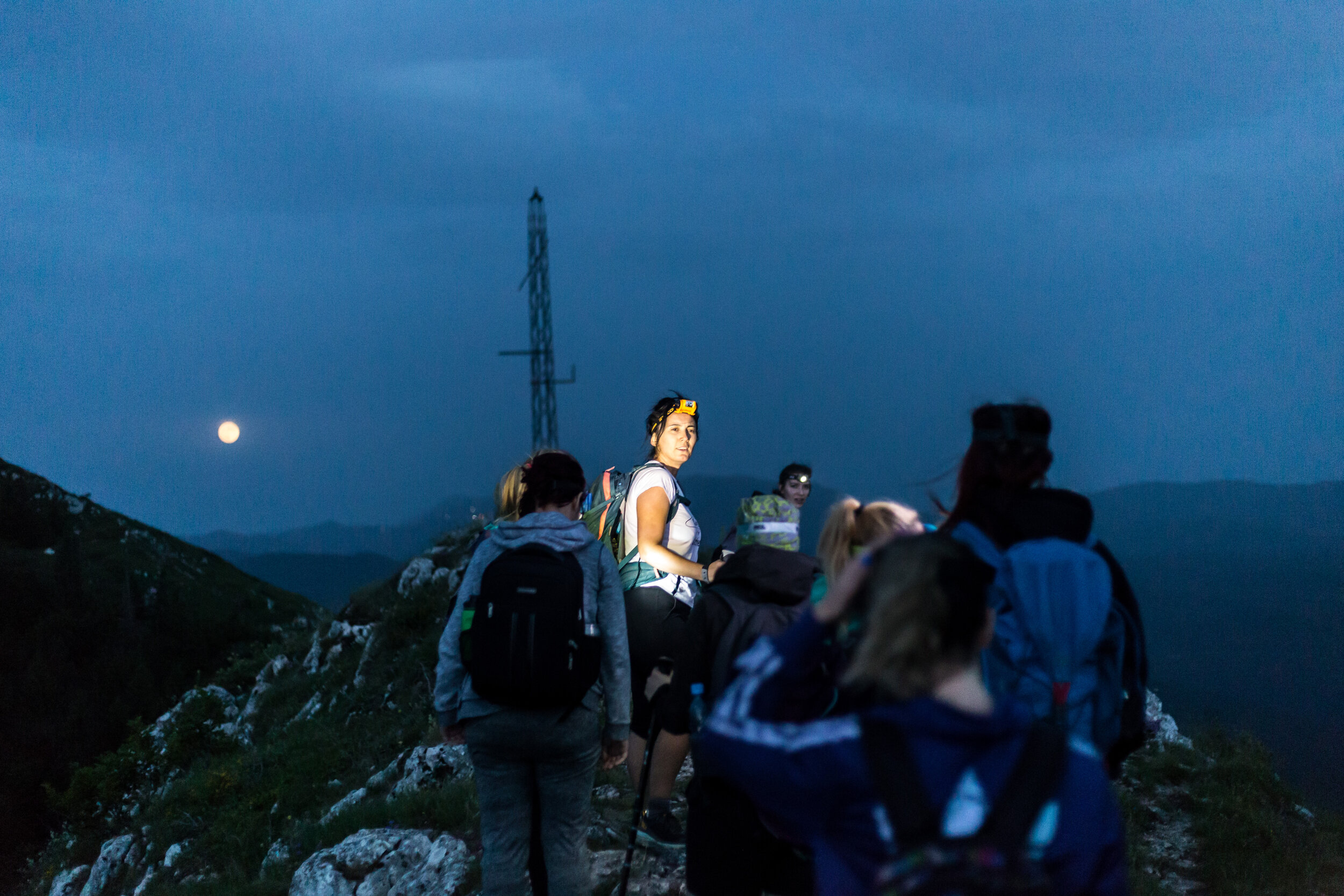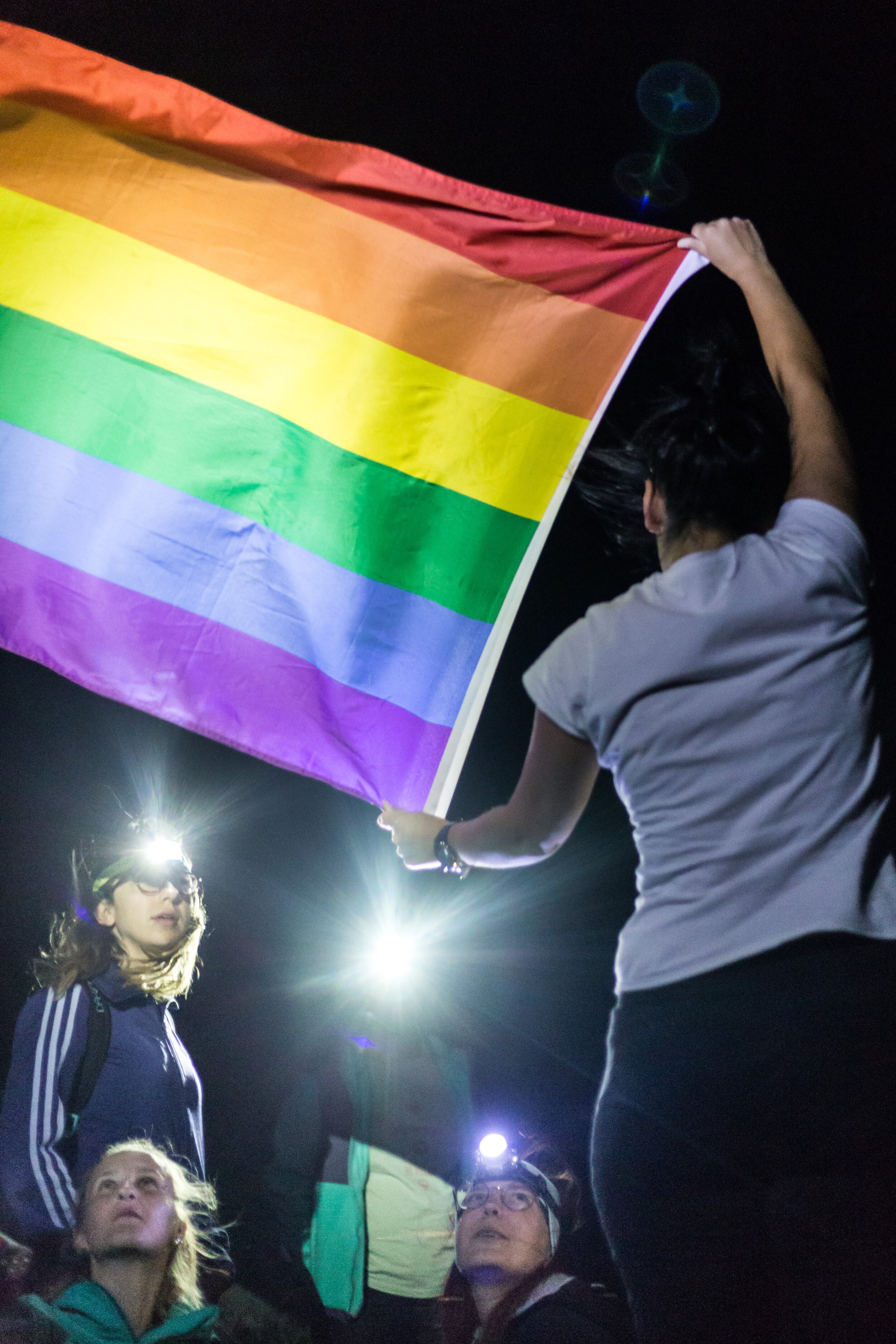Searching for Space: LGBT in Sarajevo
Published in KUMA International’s second issue of Mahala Magazine, 2021.
On 24 June, the night of the “Strawberry Supermoon,” qSport--an LGBTQIA+ outdoors and environmental collective--brought their formed family together on the summit of Mt. Trebovic to watch the sunset and take in the power of the moon. Damir, tall and bearded, his zen-like quality immediately apparent, was amongst the group who trudged along one by one, like ants crawling in serene quietude.
Climbing back down the mountain in boustrophedonic fashion, turn after turn, head lamps shining into the abyss of the black night, Damir, turning inward into his own human abyss, tranquilly shed light on his feeling of liberation at being with qSport after the isolation of the pandemic.
Often ignored or actively stifled by media and the government, and vulnerable to discrimination and harm, Damir and other members of the LGBTQIA+ community are often left to search for acceptance and the ability to be their true selves in “safe spaces”--social environments that allow for freedom of expression away from judging and prying eyes. But when the COVID-19 pandemic hit, LGBTQIA+ people suddenly had many of their safe spaces pulled out from under them.
It was only in 2019, those pre-pandemic times, that BH Povorka Ponosa (Bosnian Pride March), organized the country’s first ever pride parade, bringing together an astounding 3,000 attendees. Maida Zagorac, a member of the organizing committee, proudly proclaimed it was the first pride parade in the entire region without any instances of violence—an important accomplishment considering the burtality that anti-gay protestors inflicted on attendees of the 2008 Sarajevo Queer Festival.
Finding public safe spaces for the LGBTQIA+ community here in Sarajevo has always been difficult. Some bars/clubs and other venues publicly supported the community, such as Fis and Art Cinema Kriterion, closed before the pandemic, while G Point closed due to it. Afterwards, Sarajevo was left virtually devoid of public LGBTQIA friendly spaces, and without a second pride march in 2020.
Now, with the lifting of a majority of pandemic safety measures, more visible LGBTQIA+ organizations like Sarajevo Open Center (SOC) and Bosnian Pride March held events ushering the community back from online platforms, while individuals and smaller collectives did their part in gathering and supporting one another, from hiking under the full moon with qSport, to alternative art exhibitions with ODRON, a grassroots interdisciplinary artist and activist collective.
Damir found a safe space through pandemic times (and before) through qSport. Led by a spunky, charming, and delightfully pedagogic woman named Sabina, qSport has held over 1,000 events in the past 5 years alone, forming an endearing queer family along the way. In lieu of the 2020 pride march, qSport cycled around Sarajevo while waving rainbow flags, as passersby cheerfully honked their car horns. They didn’t let the altered world stop them from reminding Sarajevo of their existence and gathering meaningfully.
The night of that hike had a very special significance to Damir—earlier that day he came out to his mother as bisexual. “That was a stressful experience,” Damir relayed as we traipsed down the mountain, “but it ended up good. She just said, OK, I’m just shocked right now, but that changes nothing, you know I still love you and all that stuff. It meant a lot.”
However, everyone’s journey towards acceptance moves at its own pace, both within and outside the LGBTQIA+ community. Artist Amina Šatrović, petite and zestful yet down-to-earth, had three of her paintings exhibited at a Bosnian Pride March event. However, she expressed reservations about attending: “I have to admit, I was a bit nervous…even though I’m out to most of my friends and everything, I don’t really know a lot of people in the LGBTI community.”
Courage and communication go hand in hand, especially in the LGBTQIA+ community. Whether nerves about labels within the community or coming out, it is important to simply listen. In regard to the Bosnian Pride March’s event, Zagorac articulated that “we are here to fight for human rights of LGBTIQ people. It is very important for us to be to hang out with LGBTIQ +people, to listen and to understand them.”
At Kvirhana Festival, same sex couples couples kissed under dim dancefloor lighting, friend groups gleefully hollered and gyrated, and crowds threw up their hands and “whooped” at Dragoslavia drag performances.
The three day, publicly-advertised queer arts festival put together by the SOC, featured a photo exhibition, apropos panel discussions and documentaries, and more. Amina Imamovic, who coordinated the project, emphatically stated the goal was “to show the community that we can create something that is ours.”
But creating safe spaces isn’t easy, even from an internal perspective. Šatrović, said that “amongst [the LGBT community], we still have a lot of prejudice when it comes to different labels. I think we have to work a lot on this healthy environment.” Nevertheless, Šatrović had fun at Bosnian Pride March’s gathering, and is excited for upcoming LGBTQIA+ events in Sarajevo.
At the close-mouthed (one needed to message the organizers about location of the party) Bosnian Pride March event, old friends mingled and new friendships formed. Drinks flowed, cigarettes burned, voices and laughter cackled over the loudspeakers, carried off into the dimming sky. In the burgeoning darkness, colorful wall lights emerged, transforming the backyard into a small queer dance club.
Next to the lively DJ stand, Emma, seated and surrounded by friends, proudly exclaimed, “it’s a good atmosphere—it’s accessible and everyone feels safe. I’m very happy to be here.”
Šatrović’s paintings, expressions of growth, transformation and learning, commented on how we “as an lgbtiq community have a lot of obstacles to overcome and challenges to accomplish.”
Art has always been a popular medium for people in the LGBTQIA+ community to express themselves and their journeys. Before the pandemic and up until current times, ODRON has been a vital source of art, activism, and refuge to the LGBT community, offering an inherently safe space since 2018. In its still young collective life, ODRON has hosted queer raves, jam sessions for musicians, cinema screenings, discussions, with a focus on arts, culture and politics. They’ll be hosting an art exhibition in July.
Sitting in the kitchen of ODRON, a copy of the Mona Lisa watching over the colorful table and chairs, while string lights illuminated the tiled walls artistically littered with stickers, drawings, and powerful quotes, founder Kasija talks about ODRONs hushed but pervasive presence in Sarajevo. She explains it is “quite obvious” that ODRON is a queer friendly space. Leftist, progressive, queer and political--the whole point of ODRON is “creating culture that encompasses these identities,” she says. It’s all mutually inclusive.
Whether queer social nights, festivals, hiking excurions, grassroots art and activism gatherings and exhibitions, these nearly post-pandemic events, no matter the amount of people in attendance or scale of organization, show the resilience and necessity of this vital community to the heart of Sarajevo, Bosnia, and beyond.
Up on Trebević, Damir relished in releasing built-up stress and pressure after his emotional rollercoaster of a day. “Throughout the pandemic you’re breathing in smoggy air, and you can only feel like the walls around you are claustrophobic,” mused Damir. “This is a complete, opposite feeling” he says, addressing not only being in the great outdoors, but his newfound openness in himself.

